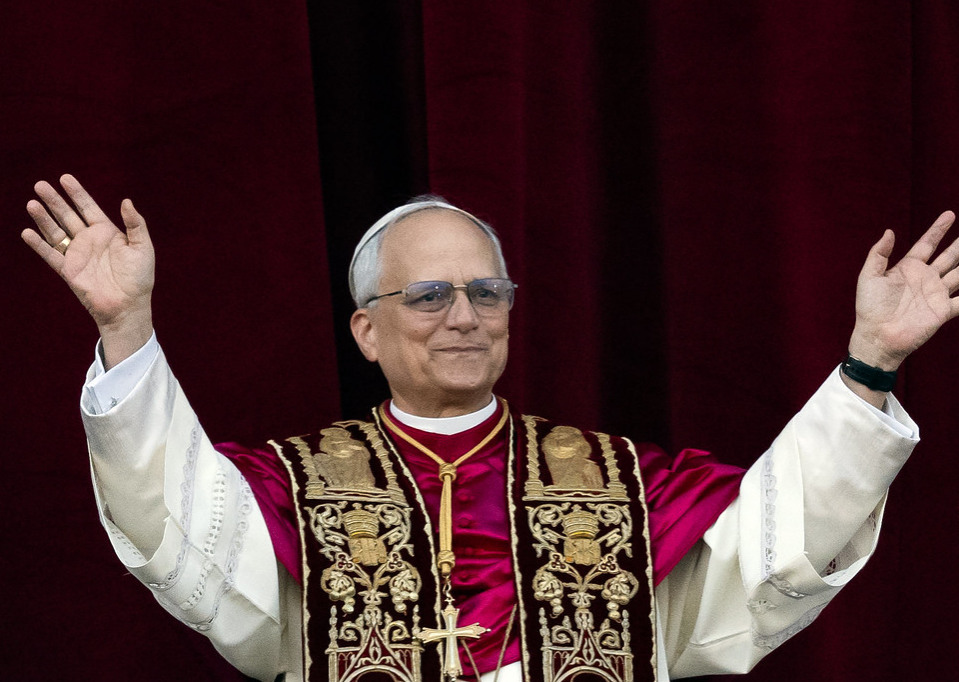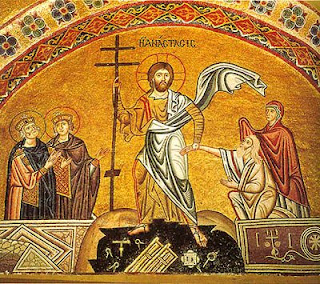The Good Shepherd (Blessed Ildefonso Schuster)
 Peace be with all of you!
Peace be with all of you!Dearest brothers and sisters, this is the first greeting of the Risen Christ, the good shepherd who gave his life for God’s flock.’
(Pope Leo XIV Opening address, 8 May 2025)
2nd Sunday after Easter
Station at St Peter’s
The Good Shepherd
1. Today, in ancient times, the Station was at Saint Peter’s, where, at the tomb of the Shepherd of the Church, the Pope would put on the Regnum [tiara]; then he would celebrate the Mass, and the Responsory would be sung: Surrexit Pastor bonus, qui pro grege suo mori dignatus est: ‘The good Shepherd Who deigned to die for His own flock is risen from the dead.’
***
The Holy Gospel today recognises three qualities in the good Shepherd:
a) He knows all His little sheep1 by name.
b) He gathers them in one single sheepfold.
c) He gives His life for them.
Saint Benedict applies this lesson of the good Shepherd to the Abbot, and he desires above all that he should know so well the different characters of each little sheep of his flock, that he might adapt to each one the proper discipline:
‘Let the Abbot know’—he writes—‘what a difficult and arduous task he undertakes in ruling spirits and in having to adapt himself to the tastes of so many people. This one you take gently, that other with reprimands, another instead one must persuade with good arguments. Each one must be taken according to his respective gifts and intelligence. The Abbot then should so conform and adapt himself to all that the flock not only may not stand to suffer any loss, but that he himself, the shepherd, may instead rejoice in the increase of his good little sheep.’ (Rule, Ch. 2)
***
2. Jesus the Saviour gathers the Church from the four winds of the earth and brings it back into unity under one same shepherd, and in the community of one same supernatural family. Ut sint unum, sicuti ego et tu unum sumus. (John 17:22: ‘That they may be one, as I and Thou are one.’)
Even in the Cloister, warns Saint Benedict, there can be found stray little sheep, whom the Abbot must therefore mercifully lead back to the sheepfold, that is, to the regular observance of the Community.
In Chapter 27 of the Rule, on the solicitude of the Abbot towards these excommunicated, the Holy Patriarch expressly invokes the example of Jesus, the good Shepherd:
Et Pastoris boni pium imitetur exemplum, qui relictis nonaginta novem ovibus in montibus, abiit unam ovem quae erraverat quaerere. (Rule, Ch. 27: ‘Let him imitate the touching example of the good Shepherd who, leaving the ninety-nine little sheep on the mountains, went off to seek that sole one which had strayed.’)
And indeed, so great is the compassion of this good Shepherd, that when he has found the lost little sheep, he takes it on his shoulders and carries it back to the sheepfold.
To bear in charity others’ miseries is to take the little sheep upon one’s shoulders. It is written: Homines et iumenta salvabis, Domine. (Ps 35: ‘Thou, O Lord, dost provide for men and animals.’) For him who is not saved like a man, it is good to be brought to safety at least like an animal. As long as he is saved!
When Saint Benedict was treating the figure of the good Shepherd, before his mind there were the hundreds of early Christian sarcophagi and statues of Rome, where Christ or the Apostle Peter were presented to the faithful in the guise of good shepherds, with the little sheep on their shoulders.
***
3. The good Shepherd gives his life spontaneously for his own flock. Jesus already did it a first time on the Cross—comments Saint Gregory in a homily—but He continues to give it to us every day in the Mysteries of the Sacred Altar. He gave His own life, immolating Himself then on the altar of the Cross; now He gives to us eternal life in the Sacrifice which commemorates His death.
The example of Christ summons whosoever acts in His stead in the Church to imitate Him by the daily sacrifice of commanding. Saint Benedict in fact calls it onus, that is, burden, service, and he desires that the goal of the prelate’s office should be the advantage of the flock, and not indeed the miserable prestige of the prelate: Sciatque sibi oportere prodesse magis quam praeesse. (Rule Ch. 64: ‘And let him know that he ought to be of profit more than to be at the head.’)
So that the sheep may not grow weary, the abbot must walk and run himself. So that the long journey towards the sheepfold may not tire the weakest, the abbot must carry them on his shoulders. So that they may finally recover their health, the abbot must wear out his own: Noverit se infirmarum curam suscepisse animarum, non super sanas tyrannidem. (Rule, Ch. 27: ‘Let him know that he has accepted the care of infirm souls, and not indeed the tyranny over the healthy.’)
Later, Saint Gregory the Great will adapt to the Bishops these instructions of the Cassinese Patriarch [Saint Benedict] for the Abbots, and from this will come forth the marvelous volume, Liber Regulae Pastoralis.
Thus there is provided for the monks the Regula Monasteriorum.
There is provided for the Catholic Episcopate the Book of the Rule of the Shepherds.
1Throughout most of this meditation, Blessed Schuster refers to the sheep with the diminutive form pecorelle, here translated as ‘little sheep’. ↩

